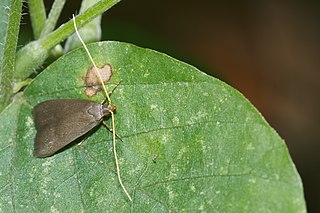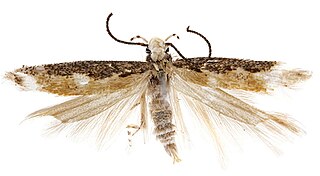
Gelechioidea is the superfamily of moths that contains the case-bearers, twirler moths, and relatives, also simply called curved-horn moths or gelechioid moths. It is a large and poorly understood '"micromoth" superfamily, constituting one of the basal lineages of the Ditrysia.

Hyposmocoma is a genus of moths with more 350 species endemic to the Hawaiian Islands. The genus was first described by Arthur Gardiner Butler in 1881. Most species of Hyposmocoma have plant-based diets, but four species, such as Hyposmocoma molluscivora, eat snails. The caterpillars spin silk, which they then use to capture and eat snails. These are the first caterpillars known to eat snails.

Spilomelinae is a very species-rich subfamily of the lepidopteran family Crambidae, the crambid snout moths. With 4,132 described species in 340 genera worldwide, it is the most speciose group among pyraloids.

Pterolonchidae is a small family of very small moths in the superfamily Gelechioidea. There are species native to every continent except Australia and Antarctica.

The Lecithocerinae are a subfamily of small moths in the family Lecithoceridae. They are found worldwide, but most species occur in South Asia. The subfamily is characterized by the male genitalia with a bridge-like structure connecting the tegumen and the valva, and the uncus almost always is vestigal with two lobes at the dorsal base, only exceptionally united into a broad plate, but never as a thorn or spine.

Udea is a genus of snout moths in the subfamily Spilomelinae of the family Crambidae. The genus was erected by Achille Guenée in 1845. The currently known 214 species are present on all continents except Antarctica. About 41 species are native to Hawaii.

Lygropia is a genus of snout moths in the subfamily Spilomelinae of the family Crambidae. It currently comprises 66 species, which are mostly found in the tropical and subtropical regions of the Americas, Africa and Asia, but not in Australia.
Aphomia pimelodes is a species of snout moth in the genus Aphomia. It was described by Edward Meyrick in 1936. It is found in Zimbabwe.
Copamyntis ceroprepriella is a species of snout moth in the genus Copamyntis. It is found in Australia.
Copamyntis leptocosma is a species of snout moth in the genus Copamyntis. It is found in Australia.
Copamyntis martimella is a species of snout moth in the genus Copamyntis. It was described by Valentina A. Kirpichnikova and Hiroshi Yamanaka in 2002 and is known from Primorsky Krai, Russia.
Copamyntis prays is a species of snout moth in the genus Copamyntis. It is found in Australia.
Copamyntis spodoptila is a species of snout moth in the genus Copamyntis. It is found in Australia.
Epacternis is a genus of snout moths. It was erected by Edward Meyrick in 1933.
Thylacoptila is a genus of snout moths. It was described by Edward Meyrick in 1885.
Titanoceros is a genus of snout moths. It was described by Edward Meyrick in 1884.

Gelechiinae is a subfamily of moths in the family Gelechiidae. It was described by Henry Tibbats Stainton in 1854.
Agroterini is a tribe of the species-rich subfamily Spilomelinae in the pyraloid moth family Crambidae. The tribe was erected by Alexandre Noël Charles Acloque in 1897.

Margaroniini is a tribe of the species-rich subfamily Spilomelinae in the pyraloid moth family Crambidae. The tribe was erected by Charles Swinhoe and Everard Charles Cotes in 1889.








